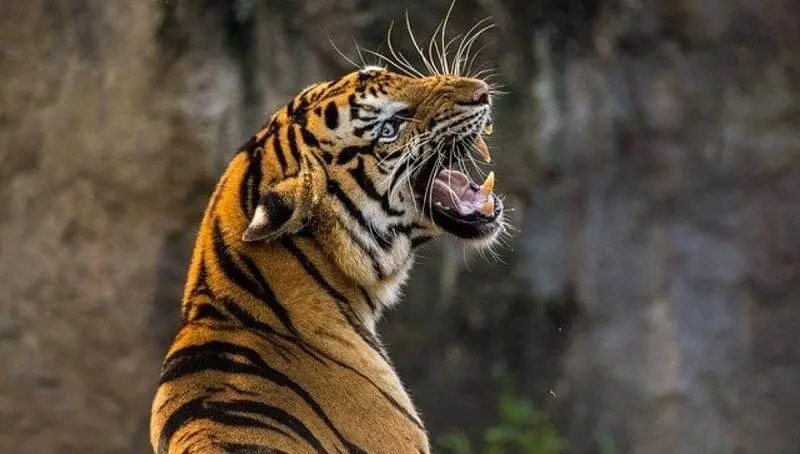The tiger is spread in South-East Asia and, in the north reaching as far as Eastern Siberia. The tiger is a symbol of power and monarchy in Asian culture. Some Indian deities are depicted riding tigers, thus demonstrating their superiority. Its role in the world’s culture is reflected in its recognition as the national symbol of Malaysia, India, Bangladesh, and the Republic of Korea.
The tiger is the largest feline in the world. Its fur is orange-red, with vertical black stripes of varying sizes, and located at different distances between them. In some subspecies, the fur has lighter shades and can be completely white with dark vertical stripes. The chin, neck, chest, abdomen, and lower limbs are light or even white. Above the eyes, the coat is white, and behind the ears, there is a white spot. The tail is orange-reddish in color, with several dark stripes.
Tigers are like many other large cats and have vocal cords. In tigers, it’s the shape that allows them to make that loud roar that everyone knows.
Tigers communicate through facial and vocal expressions. The most common facial expression is the “defensive posture,” in which the animal shows its fangs, flattens its ears, and its pupils enlarge. Like other members of their family, the tigers roar, especially in aggressive situations, during mating season, or when they kill their prey. Other modes of voice communication are growling, mumbling, and meowing.
Tigers are solitary animals, except for mating season and when females give birth. They like to be alone and roam their huge territories in search of food. Tigers are territorial animals, marking their territory by scratches left on trees. They are usually most active during the night when their prey is active, but they can also hunt during the day.
Why do tigers roar?
Like all big cats, tigers chase and throw themselves at their victims. The chuffing risks alerting the prey about their presence and scaring them. Scientists have found that tigers roar when provoked, threatened, frightened, or for attention. For the most part, tigers roar at other tigers.
You might also like my articles on why lions roar, whether lions eat hyenas, and what is a group of lions called.
Attention Roar
When a female tiger gives birth, it will take care of its cubs for a period of time of up to 2-3 years. In order to draw their attention, the mother will roar at them.
It is the female’s duty in the first 6 to 11 months, to train its cubs to hunt, as it is their way to survive. The female may roar just to be sure that the cubs follow it or to encourage them to try something new.
The tiger cubs are considered fully independent around the age of 18 months, even though they can stick around their mother for up to 3 years.
Territorial Roar
Tigers are solitary animals and usually roar to express their intentions in the most direct way. They roar to indicate their dominance and territoriality, while a groan indicates submission. This is the case when they warn each other to prevent useless conflicts, as they can have shared resources of water. The roar can grant the other a safe passage.
They always mark their territory depending on how much food they can find. They will roar to be heard by others and let them know their exact location.
Threatening Roar
When tigers feel in danger or threatened by someone or something they will definitely roar. One example is when tigers fight each other, due to territorial conflicts. These fights can lead to real injuries or can even be lethal.
As you may know, the tiger is still hunted as a trophy and it won’t back up, it will roar at its hunter in order to attack back.
How strong is a tiger’s roar?
The roar of a lion or tiger can reach 114 decibels for someone who is a few meters away, which is about 25 times louder than a lawn mower.
Humans can only hear sounds whose frequency is greater than 20 hertz (Hz), but in the tiger’s roar we can also hear growls, more precisely infrasound, with a frequency of 18 Hz, and even lower. Therefore, people simply feel this roar, as a sensation that for the moment paralyzes them. Even experienced trainers felt this.
New research shows that very low-frequency sounds may be the key. The intimidating roar of a tiger has the power to paralyze the animal that hears it, and that includes even experienced, human trainers.
How strong is the roar of a lion?
 Male lions will use their roar to scare off intruders and warn the herd of potential danger. Both male lions and female lions demonstrate ownership of their territories through roaring and are able to assess the power of opposition based on the number of roars heard from other groups.
Male lions will use their roar to scare off intruders and warn the herd of potential danger. Both male lions and female lions demonstrate ownership of their territories through roaring and are able to assess the power of opposition based on the number of roars heard from other groups.
It is also a demonstration of power among other males. The lion’s roar can be heard up to 8 km away.
The lion has the strongest roar of all the big cats. It is so powerful that it can reach 114 decibels, at a distance of about one meter, and can be heard from a distance of 8 km.
A lion or tiger can roar up to 114 decibels, about 25 times louder than a gasoline-powered lawn mower. Felines are also helped by the power of their vocal folds, which can withstand stretching and shearing, as the air passes by them and the folds vibrate.
Do tigers and lions roar the same?
The question about which roar is more powerful, that of the lions or that of the tigers, is questionable. This is because both animals will emit roars that reach up to 110 to 114 decibels. So, I cannot say it is a big difference between them.
Which are the big felines that can roar?
Large cats like lions, tigers, leopards, and jaguars can roar, but they cannot purr. Poots and smaller cats like ocelots, lynx, and domestic cats, among others, may purr, but they cannot roar.
A large cat that purrs but cannot roar is the Cheetah. Biologists place it in a special genus, Acinonyx, simply because it cannot fully retract its claws. Also unique to the Cheetah is a sharp chirp, which is said to resemble that of a Canary.
Final words
There are currently fewer tigers in their natural habitat than the number of tigers in captivity in the United States. Without the adoption of firm measures to protect this species, tigers could completely disappear from their natural habitat in less than a generation.
A century ago, the population of wild tigers reached 100.000. The number has now fallen below 4.000. The species is threatened by various factors, such as poaching, habitat loss and fragmentation, conflict with humans, or excessive hunting of the species on which tigers feed. Unless humanity takes swift action to protect the species, the tiger roar will completely disappear from the face of the earth.




